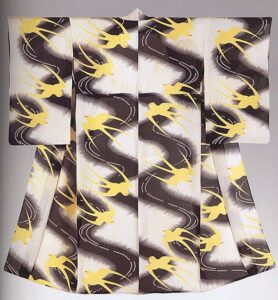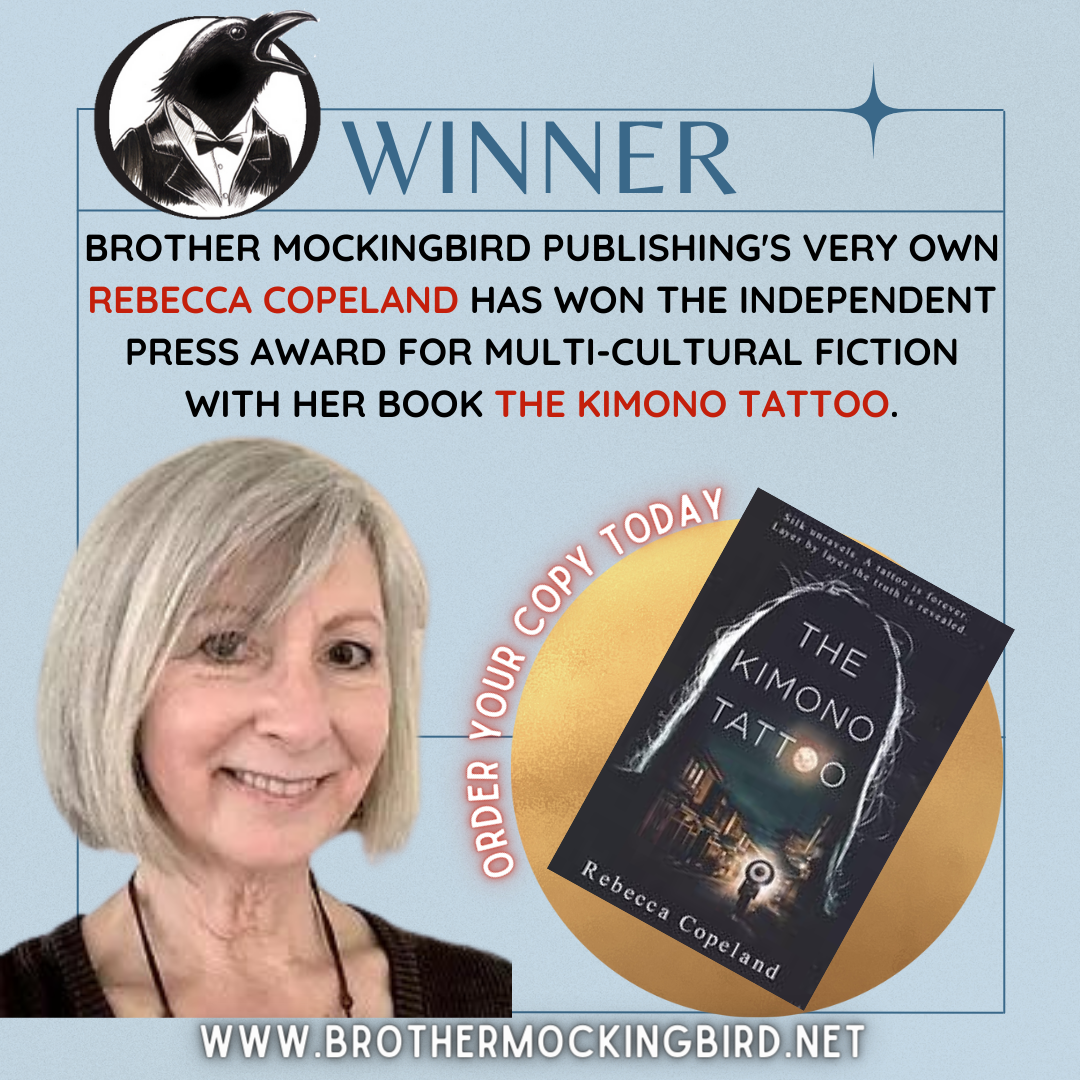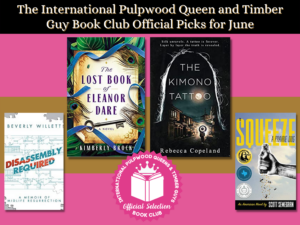Happy news for fans of mystery writer Rebecca Copeland. Her book The Kimono Tattoo has won the 2022 Independent Press Award in the category of Multi-Cultural Fiction.
Silk unravels. A tattoo is forever.
Layer by layer the truth is revealed.
— The Kimono Tattoo
A fast-paced mystery set in Kyoto, The Kimono Tattoo follows American translator Ruth Bennett on her risky quest for the truth about a bizarre murder. Ruth’s expertise in kimono history and fluency in Japanese give her the tools. Her host of friends come to her aid. Readers enjoy traversing Kyoto, too. From ancient temple grounds to convenience stores and hidden tattoo parlors, we’re soon on the beat with Ruth.
Let’s catch up with Rebecca Copeland to get her thoughts on this well-deserved Indie Award.
What is the Independent Press Award?
JB: Congratulations, Rebecca. What’s the story of this award?
RC: Thanks, Jan. The Independent Press Award aims to bring attention to independent publishers across the country and the great variety of books they publish. I’m grateful to my publisher Brother Mockingbird for nominating The Kimono Tattoo.
The Independent Press Award recognizes excellence by category. As you can imagine, they need lots of categories to cover the myriad kinds of books published every year. There’s action and adventure, horror, historical fiction, advice guides, and many more. The Kimono Tattoo won in “Multicultural-Fiction.”
Experiencing Multicultural Kyoto — Past and Present
A window on how people experience cultural identity…
a sense of home and belonging
JB: Thinking about The Kimono Tattoo as multicultural gives me a new way to look at your mystery. One that draws on my own experiences of Kyoto.
I recognized the mystery’s setting and the kinds of characters right away…..well, except for the criminal ones…from my times in Kyoto and the people I met. There’s the lead, Ruth, a bilingual American expat, and her sidekick Maho, who feels more American than Japanese, and the elegant Japanese entrepreneur, Mrs. Shibasaki. This kind of “expat in Japan” circle felt so familiar to me.
But, in fact, The Kimono Tattoo does more than that. You give us a window on how people experience cultural identity and work to achieve a sense of home and belonging.
Creating complex characters
RC: Thanks for that point. Yes, as I imagined Ruth and the other characters, I inevitably mapped them onto my understandings of Japan society, especially its literary traditions and kimono design world. And I built some — especially Ruth and Maho — around lives shaped by bilingual and bicultural experiences. But I also saw each character as unique, as more than the sum of their language, education, and social class.
The Brilliant, Elusive Satoko — Mastermind of the “Kimono Tattoo”
JB: Satoko, the elusive mastermind behind the “kimono tattoo,” certainly strikes me as motivated by more than her background and even her family’s commercial involvement with kimono. She’s a brilliant artist. And her creativity ties her to the material and cultural history of kimono, and even ghosts!

Unlined Kimono for a Woman (Hitoe) Motif: Swallows flying over and streams (1910-1920). Khalili Collections. Wikimedia Commons.
RC: I find Satoko’s trajectory fascinating, too. Part of the fun of writing The Kimono Tattoo came from doing the research needed to depict that history well and to invent new legends that furthered my own plot and helped build Satoko’s character.
JB: In that way, The Kimono Tattoo not only opens our eyes to the multicultural interactions of people in contemporary Kyoto but invites us to consider a multicultural past. Japanese characters and customs do not emerge as monolithic or uncomplicated. That is, we learn about customs, dance, fashion, family structures, and even Japanese literature, too.
RC: Thank you for noticing that. So many in the States still think of Japan as such a remote and strange place. I’ve spent my career—as have you—trying to make Japan more approachable, teaching students about Japanese culture while at the same time challenging them to think more deeply about their own cultural practices and biases. Travel is one way we learn more about ourselves!
A novel slips readers into a new space
I hope that The Kimono Tattoo will carry readers to Kyoto, enticing them to learn more about Japanese culture. At the same time perhaps it will push readers to question their own assumptions and misunderstandings. I don’t know. It’s a lot to ask! And I want the novel to also be “entertaining.” I think that’s what distinguishes the novel from my earlier academic books. A novel slips readers into a new space without making too many demands, and before they know it, they’re walking around in a different world.
The Kimono Tattoo – An Official Book Club Pick for June
JB: I see, too, Rebecca, that The Kimono Tattoo has earned yet another honor! It’s been chosen as the “International Book of the Month” for the month of June by the International Pulpwood Queens and Timberguys Book Club.
RC: Yes! I was so excited about that. The International Pulpwood Queen and Timber Guy Book Club is the largest book club in the world with regular meetings and discussions. There are over 800 chapters with 20 chapters in foreign countries.
The Club holds an annual convention. This year the convention was virtual with zoom meetings all day long for a week! My publisher and I were invited to have a conversation about The Kimono Tattoo on one of the afternoons. The amount of participation and enthusiasm for BOOKS and for reading that this Book Club generates is truly invigorating. It’s an honor to have The Kimono Tattoo represent the month of June.
JB: Congratulations again on these honors, Rebecca. And I can’t wait to read the next of Ruth’s adventures.
For more on how Rebecca Copeland created The Kimono Tattoo, visit her blog: https://www.rebecca-copeland.com/blog/
For my other interviews with Rebecca, see these past posts:
Jan Bardsley. “The Kimono Tattoo Wins Indie Award.” Janbardsley.web.unc.edu. March 24, 2022.





Wow! Thank you so much for this wonderful post! And thank you always for your warm support. On this Women’s History Month, may I just say how important and meaningful it is for women to support each other! Big thanks!
I’ve enjoyed following the success of The Kimono Tattoo, Rebecca, and I liked reading it even more. Thank you for all you’ve done to further the study of Japanese women writers.
Hi Jan, I would say that not just in the States but in many countries people still think of Japan as a remote and strange place. I mean people who have not come here or came here in touch & go fashion believing that. I remember the first time when I came here 22 years back. It was kimonos and dolls and samurais in the mind. An exotic image that I had always loved since I was a kid.
It really takes time and effort to understand Japan because the public face any Japanese would have is always different. They look reserved with all the discipline they learn from childhood and would remain so if you do not try to unlock those doors.
I just came across your blog yesterday and decided to slowly read all your posts. I think I can still learn from these even after living here for 20+ years. You have depth.
Thank you, HJ. I appreciate your reading the blog. And I see you discovered Rebecca Copeland’s, too. Her novel set in Kyoto, The Kimono Tattoo, is a great read. Interesting to see how the exoticism and playfulness of some aspects of Japan still attract. Jan
Yes, Jan, I found her blog from your blog only.
Japan has been quite close to my heart – I think that was a reason that I ended up settling down here after landing here for a mere 2-months project. It’s now 20 years.
I see two types of foreigners – one type who live here or visit often but still don’t stop Nihon-bashing. And others who try to go into the depths and try to see the better points.
As I always say that no person or place is perfect. Everyone has it’s own spectrum of colors, and it depends on us how we decide to see those.
Thanks, HJ. Truly, it’s good to look at cultures with a balanced perspective. Japan has so many interesting aspects to explore, I always feel that I’m just scratching the surface. Jan